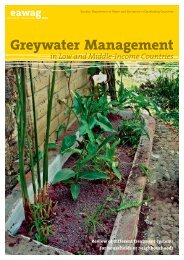Household Water Treatment and Safe Storage Factsheet: Source ...
Household Water Treatment and Safe Storage Factsheet: Source ...
Household Water Treatment and Safe Storage Factsheet: Source ...
Create successful ePaper yourself
Turn your PDF publications into a flip-book with our unique Google optimized e-Paper software.
<strong>Household</strong> <strong>Water</strong> <strong>Treatment</strong> <strong>and</strong> <strong>Safe</strong> <strong>Storage</strong><br />
Fact Sheet: <strong>Safe</strong> <strong>Storage</strong> <strong>and</strong> H<strong>and</strong>ling<br />
<strong>Treatment</strong> Type<br />
Potential Protection Capacity<br />
Very Effective For: Somewhat Effective For: Not Effective For:<br />
Preventing recontamination of<br />
safe water<br />
Keeping water cool<br />
Preventing algae growth<br />
Removing existing<br />
contaminants<br />
What is <strong>Safe</strong> <strong>Storage</strong> <strong>and</strong> H<strong>and</strong>ling?<br />
<strong>Household</strong>s do a lot of work to collect,<br />
transport <strong>and</strong> treat their drinking water. <strong>Safe</strong><br />
water must be h<strong>and</strong>led <strong>and</strong> stored properly<br />
to protect it from becoming recontaminated.<br />
Promoting safe storage <strong>and</strong> h<strong>and</strong>ling of<br />
water in the home is a critical component for<br />
safe drinking water. Recontamination of safe<br />
drinking water is a common issue around<br />
the world <strong>and</strong> has been documented in<br />
several cases.<br />
What Causes Recontamination?<br />
<strong>Water</strong> can become recontaminated through<br />
several different mechanisms, such as:<br />
<br />
<br />
<br />
<br />
<br />
Using the same container for water<br />
collection <strong>and</strong> storage<br />
Dipping a dirty cup or h<strong>and</strong> into the<br />
container<br />
Drinking directly from the container<br />
Children, animals or insects accessing<br />
the container<br />
Poor cleaning <strong>and</strong> hygiene practices<br />
Recontamination is more likely to occur in<br />
uncovered containers that have wide<br />
openings (e.g. buckets, pots). Using chlorine<br />
can provide residual protection against<br />
recontamination, however, proper storage<br />
<strong>and</strong> h<strong>and</strong>ling are still essential for keeping<br />
water safe to drink.<br />
<strong>Safe</strong> <strong>Storage</strong> <strong>and</strong> H<strong>and</strong>ling Practices<br />
<strong>Safe</strong> storage means keeping treated water<br />
away from sources of contamination. There are<br />
many designs for water containers around the<br />
world. A safe water storage container should<br />
be:<br />
With a strong <strong>and</strong> tightly-sealing lid or<br />
cover<br />
With a tap or narrow opening at the<br />
outlet<br />
With a stable base so it does not tip over<br />
Durable <strong>and</strong> strong<br />
Not transparent or see-through<br />
Easy to clean<br />
<strong>Safe</strong> storage containers should also have<br />
pictorial <strong>and</strong>/or written instructions<br />
describing how to properly use <strong>and</strong> clean<br />
the container. Ideally the instructions are<br />
permanently affixed to the container, or they<br />
can be provided as a separate document to<br />
the household.<br />
Sometimes it is difficult for rural <strong>and</strong> poor<br />
households to find or buy good storage<br />
containers. The most important things are to<br />
make sure that they are covered <strong>and</strong> only<br />
used to store treated water.<br />
<strong>Safe</strong> water h<strong>and</strong>ling practices include:<br />
<br />
Using a separate container to collect<br />
source water
















